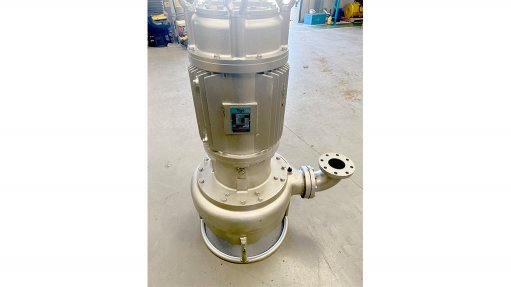
CUT OUT FOR THE JOB The cutter fan plays a crucial role in achieving effective agitation and solids handling during arduous pumping applications
The integration of innovative features in pump design has significantly enhanced performance and efficiency, with significant benefits for lowering total cost of ownership. One such component, the cutter fan, plays a crucial role in achieving effective agitation and solids handling.
Cutter fans have significantly contributed to the efficiency and effectiveness of pump systems, particularly in managing solids and enhancing agitation. With a deeper understanding of pump applications and the role of cutters, the cutter fan’s ability to redirect fluid and maximise solids management exemplifies the advancements in pump technology.
Official distributor of Toyo heavy-duty slurry pumps in Southern Africa IPR’s business development manager Ruaan Venter sheds light on the functions and applications of these components, offering valuable insights into their importance in pump systems.
Enhancing Agitation, Solids Handling
The cutter fan, also known as an agitator, has “revolutionised” heavy-duty submersible dredge pumps. Toyo Pumps was the pioneering manufacturer to incorporate this type of agitation into its designs.
Venter says its patented curved three-blade stirring attachment, threaded onto the pump shaft just below the suction inlet, became a game changer in handling solids-laden slurries.
The primary function of the cutter fan is to dislodge and resuspend solids, creating a slurry. As fluid flows towards the pump suction, the cutter fan redirects a portion of the fluid away from the pump, generating a fanning effect. This redirection and cyclic process results in a concentrated “pocket” of high solids content slurry directly in front of the pump suction inlet, maximising the pumping efficiency and effectiveness, making it an essential feature for dredge pumps.
To protect the cutter fan, a stand is attached to the bottom of the pump and for larger pumps, an additional stub shaft is placed between the pump’s main shaft and the cutter fan, providing extra protection and stability during operation.
DifferentiatIon
During pump installation, it is crucial to differentiate the cutter fan from other components as operating the pump with a reversed rotation can lead to unscrewing of components during operation, resulting in potential damages and costly repairs.
To identify a cutter fan correctly, it is advisable to consult the pump’s rotational arrow, observing the marked arrow during pump wiring ensures the correct rotation and installation of the cutter fan. The cutter fan is easily visible and recognisable, as it pushes fluid away from the pump for agitation purposes.
“By correctly identifying and using cutter fans, pump operators can ensure optimal performance and avoid unnecessary operational issues,” Venter comments.
Amphibious Toyo VH Pumps In a previous press release in August, IPR noted that Amphibious heavy-duty pumps like the Toyo VH range, are designed to operate effectively in challenging environments where versatility and durability are “paramount”. The “robust”pumps can function both above the water and under the water, making them an ideal solution for diverse applications across the mining, oil and gas, construction and agricultural sectors. Venter, at the time, commented that the usefulness of the Toyo VH amphibious pump extends to environmental cleanup and remediation efforts, where the units will “effectively and efficiently” pump out contaminated groundwater or surface water, even when the water is laden with solids or sediment. “In wastewater treatment facilities, Toyo VH pumps handle sludge and other dense materials, while in the agricultural industry, these amphibious pumps are key in irrigation and drainage systems, especially in flood-prone areas. “Their ability to function both submerged and above water is crucial in maintaining optimal growing conditions by controlling water levels in fields.” Venter added that the industrial sector also heavily relies on these pumps’ versatility. “They are used in processing plants across industries such as food processing, chemical and petroleum, where they handle slurries.” Their robust construction allows them to manage corrosive and abrasive fluids, solidifying them as a reliable choice for demanding industrial environments.